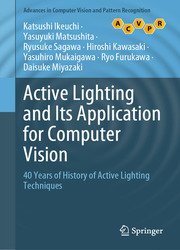 Название: Active Lighting and Its Application for Computer Vision: 40 Years of History of Active Lighting Techniques
Название: Active Lighting and Its Application for Computer Vision: 40 Years of History of Active Lighting Techniques Автор: Katsushi Ikeuchi, Yasuyuki Matsushita, Ryusuke Sagawa
Издательство: Springer
Год: 2020
Страниц: 309
Язык: английский
Формат: pdf (true)
Размер: 18.4 MB
Computer vision entails both passive and active illumination techniques. Whereas passive techniques observe the scene statically and analyse it as is, by contrast active techniques give the scene some actions and try to facilitate the analysis. In particular, active illumination techniques project specific light, for which the characteristics are known beforehand, to a target scene to enable stable and accurate analysis of the scene. Notably, traditional passive techniques have a fundamental limitation: The external world surrounding us is three-dimensional; the image projected on a retina or an imaging device is two-dimensional (That is, reduction of one dimension has occurred). Active illumination techniques compensate for the dimensional reduction by actively controlling the illumination. The demand for reliable vision sensors is rapidly increasing in many application areas, such as robotics and medical image analysis. This book explains this new endeavour to explore the augmentation of reduced dimensions in computer vision.
Physics-based vision, one school of computer vision, tries to model the common sense in image formation processes. First, the image formation process from the original 3D world to a 2D projection is formulated using rigorous mathematical models based on the optics and physics. Then, the inverse process is solved by augmenting the dimensional reduction by introducing mathematical formula to represent the common sense.
It is the time to refocus on active lighting methods. Since the introduction of photometric stereo techniques, other active-lighting methods have been developed such as time-of-flight (ToF) and light-striping techniques. Traditionally, however, active lighting has not received the necessary focus and legitimate evaluation in mainstream computer-vision science. This is probably because humans do not possess their own light sources actively controlled at their will. Active lighting is an effective way to compensate for the 3D-to-2D dimensional reduction in vision systems. Moreover, active-lighting methods can guarantee when they will work, how much accuracy they will provide, and when they will fail based on the nature of their engineering designs.
This pivotal volume comprehensively examines basic optics concepts, available active-lighting techniques, and various application domains. Primarily aimed at advanced undergraduates and beginning graduates, the book also will serve as a useful guidebook for engineers from fields both in and beyond computer vision. Additionally, the book is suitable as course material for professional technical seminars.
Скачать Active Lighting and Its Application for Computer Vision: 40 Years of History of Active Lighting Techniques